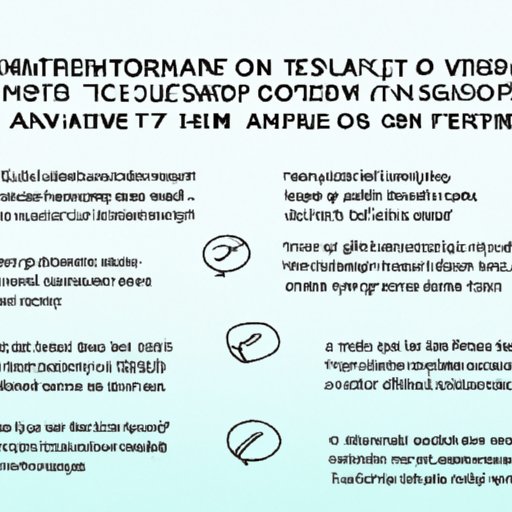Introduction
In Vitro Fertilization (IVF) is a medical procedure that involves retrieving eggs from a woman’s ovaries and fertilizing them with sperm in a laboratory setting. The fertilized egg, or embryo, is then transferred back into the uterus in hopes of achieving a successful pregnancy. This procedure has been used successfully since 1978, when the first “test tube baby” was born in England.
The purpose of this article is to explore how does in vitro fertilization work, looking at the process of IVF from start to finish, as well as the science behind it. We’ll also discuss the potential benefits and risks involved, the cost of IVF, and answer some common questions about this procedure.

Exploring the Process of In Vitro Fertilization
IVF is an involved process that can take several weeks or months to complete. Before beginning the procedure, a fertility specialist will conduct a series of tests on both partners to make sure IVF is the best option for them. Once the couple is deemed eligible for IVF, they can begin the process.
Overview of the Procedure
IVF is typically broken down into five main steps: ovarian stimulation, egg retrieval, fertilization, embryo transfer, and embryo cryopreservation. During the ovarian stimulation phase, fertility medications are used to stimulate the ovaries to produce multiple eggs. Once the eggs are mature, they are retrieved through a surgical procedure called follicular aspiration.
Step-by-Step Guide to IVF
1. Ovarian Stimulation: The first step in IVF is to stimulate the ovaries to produce multiple eggs. This is done using fertility medications such as gonadotropins and human chorionic gonadotropin (hCG).
2. Egg Retrieval: Once the eggs are mature, they are retrieved through a surgical procedure called follicular aspiration. This is usually done under sedation or general anesthesia.
3. Fertilization: The next step is to fertilize the eggs with sperm in the laboratory. This is done by combining the eggs and sperm and monitoring for signs of fertilization. If successful, the resulting embryos are cultured for 3-5 days before being transferred into the uterus.
4. Embryo Transfer: On the third or fifth day after fertilization, one or two embryos are transferred into the uterus via a catheter. This is usually done without sedation or anesthesia.
5. Embryo Cryopreservation: Any remaining embryos can be frozen for future use. This is done through a process called vitrification, which involves freezing the embryos in liquid nitrogen.
The Science Behind IVF
IVF is a complex process that requires a deep understanding of reproductive biology and embryology. According to a study published in the journal Human Reproduction Update, “IVF is a powerful technology that has revolutionized assisted reproduction, but its success depends on carefully designed protocols, precise laboratory techniques and highly skilled personnel.”

Benefits and Risks of In Vitro Fertilization
Overview of Potential Benefits
IVF can be an effective treatment for infertility, offering couples who have difficulty conceiving the chance to have a biological child. According to a study published in the journal Reproductive Biomedicine Online, “IVF has revolutionized the treatment of infertility and enabled many couples to conceive children that would not have been possible before.”
Potential Risks Involved
Although IVF offers many potential benefits, there are also risks involved. These include the risk of multiple births, ovarian hyperstimulation syndrome (OHSS), ectopic pregnancies, and birth defects. It is important to speak with a fertility specialist to understand the potential risks before starting IVF.

Cost of In Vitro Fertilization
Overview of Costs Associated with IVF
IVF can be a costly procedure, often costing anywhere from $10,000 to $15,000 per cycle. This cost typically includes medications, laboratory fees, and office visits. Some insurance plans may cover part of the cost of IVF, but it is important to check with your provider to understand what is covered.
Financial Assistance Available
There are several financial assistance programs available to help couples pay for IVF. These include grants, loans, and discounts offered by fertility clinics and other organizations. It is important to research all available options to find the best program for you.
Common Questions About In Vitro Fertilization
Overview of Frequently Asked Questions
IVF is a complex procedure that can bring up many questions. Common questions include: How long does IVF take? What are the success rates of IVF? Are there any side effects of IVF? How much does IVF cost?
Answers to Common Inquiries
IVF typically takes several weeks or months to complete. Success rates vary depending on factors such as age, cause of infertility, and number of embryos transferred. Side effects of IVF can include nausea, fatigue, bloating, and cramping. The cost of IVF ranges from $10,000 to $15,000 per cycle.
Conclusion
In Vitro Fertilization (IVF) is a medical procedure that can be used to help couples achieve a successful pregnancy. This article explored the process of IVF, including a step-by-step guide, the science behind it, potential benefits and risks, the cost of IVF, and answers to common questions. It is important to speak with a fertility specialist to understand all the potential risks and benefits before starting IVF.
For more information about IVF, please visit the following resources:
- American Society for Reproductive Medicine: In Vitro Fertilization Booklet
-
(Note: Is this article not meeting your expectations? Do you have knowledge or insights to share? Unlock new opportunities and expand your reach by joining our authors team. Click Registration to join us and share your expertise with our readers.)
